
|
On this page are useful informations about a liquid highlight of Scotland - the
Pure
Single Malt Scotch Whisky
History The Scotch Whisky The Making
of Whisky Whisky
Distilleries

It´s not clear when the first Scotch Whisky was destilled but we know that it was already in the times of the ancient Celtic tribes that "uisge beatha", the water of life, was produced so the Scots lay claim to the earliest recorded history of distilling in the world. Perhaps it were Christian missionary monks from Ireland who showed the natives how to destille it as a medicinal drink although there is no proof that the Highland farmers theirselves developed an appropriate procedure to produce it.
Although it´s an unproved fact that whisky was destilled much earlier in Scotland the earliest historical references to it dates from 1494. The Scottish Exchequer Rolls of this year mention a monk named John Cor who made some "aquavitae". The next historical trace can be found in the Treasurer´s Accounts of King James IV during his stay in Inverness in September 1506. Production was on a very small scale by farmers, monasteries and privately at home. All whisky at this point was made from germinated barley, which was dried over a peat fire making the mixture of barley and water "malted". The more peaty water could be used the stronger was the smell of the whisky capturing the aromas of the vast peat bogs that existed throughout the Highlands and islands. Therefore the Lowland malt whiskies were and are generally lighter than their Highland counterparts and more uniform in flavor. It was drunk at home much like we enjoy tea or coffee today - three times a day, and was considered medicinal as much as anything else. It was believed to preserve health, prolong life, relieve colic, palsy, and smallpox.
There weren´t any commerical whisky producing destilleries in Scotland in the 15th and in the 16th ct. We know this because of the Register of the Privy Council where it is stated that a burglar stole some "aquavitae" in a house in Gamrie/Banffshire in 1614. The earliest reference to a distillery dates from 1690, when in the Acts of the Scottish Parliament the Ferintosh Destillery was mentioned which was owned by Duncan Forbes of Culloden.
Over the centuries, the Scots have perfected the art of distilling, using elements so abundantly provided for them by nature - barley and the peaty water of their burns flowing down from the hills and mountains. No wonder that, throughout the centuries, whisky has become an essential part of Scotland´s history, traditions and culture. But whisky wasn´t always a blessing for the Scots. There were and still are a lot of troubles for those who destilled it. These troubles started in 1707 with the Union Act between England and Scotland. Suddenly the whisky producers faced severe problems caused by heavy taxation which continues until today. Moreover the laws were in such a hopeless state of confusion that no two distilleries were taxed at the same rate at the end of the 18th ct. There were only a handful of commercial stills, and the quality of the whisky from these dropped significantly as the high tax meant that they had to lower standards. Illicit distilling flourished, the smugglers seeing no good reason for paying for the privilege of making their native drink so whisky production nevertheless thrived. It is believed that at one time there were 40,000 stills in Scotland. In the famous song “Auld Lang Syne” by the Scottish poet Robert Burns, the “cup of kindness” being raised is doubtlessly whisky. Of course, there aren´t fierce skirmishes with the taxmen nowadays but in the past centuries much blood was spilled for the sake of this brown liquid.
Unlike today whisky didn´t get old in these times. It was drunk immediately or soon after the production so the spirit must have been rather harsh. Tradition has it that someone found a barrel of whisky that had been left accidentally for a long period, and noticed that the flavour had mellowed, and the whisky attained a pale golden colour thus creating the basis for today´s stringent requirements for an excellent "aquavitae".
It was in 1823 when the Excise Act was passed. This act allowed everyone to destille more than 40 gallons of whisky if he payed an annual fee of 10 pounds for the permission. The first distillery came into ‘official’ existence in the following year and thereafter many of the more far-sighted distillers came over on to the side of the law. Although the tax were impudently raised in the 19th ct a gigantic industrial branch was created establishing the Scotch Whisky as the most famous national drink in the whole world. Blended whiskies became popular later in the century, and in 1909 a Royal Commission allowed grain spirit to be described as whisky. Blended Scotch became one of the most popular spirits in the world in the 20th century. In 1995, for the first time in 150 years, the tax on Scotch Whisky was reduced.
Whisky is a great industry in Scotland and a great pleasure in the rest of the world. The industry produces millions of liters every year. You get it at the retailer or in the supermarket but a whisky lover has to make great efforts to find really good single malts there. Some retailers have very beautiful bottles, but Single Malt is expensive, and if you are not a real expert, you'll hesitate before buying a good bottle...
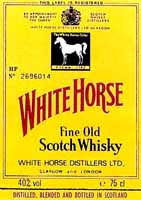 First of all, it is
important to know that there are two kinds of whisky on the market. The
first one, called "Blended Whisky", is the far most popular
one. The best known brands are J&B, Johnnie Walker, White Horse, Famous
Grouse, Chivas Regal, Dimple, and others. A blended whisky is a mix of
malts from several different distilleries and grain whisky. The proportion
of grain whisky is important to determine the quality of the final product.
The advantage of blended whisky is that it's quality is constant over the
years guaranteed by the blenders. Lovers of blended whisky use to say that
the result is superior to the sum of the composants.
First of all, it is
important to know that there are two kinds of whisky on the market. The
first one, called "Blended Whisky", is the far most popular
one. The best known brands are J&B, Johnnie Walker, White Horse, Famous
Grouse, Chivas Regal, Dimple, and others. A blended whisky is a mix of
malts from several different distilleries and grain whisky. The proportion
of grain whisky is important to determine the quality of the final product.
The advantage of blended whisky is that it's quality is constant over the
years guaranteed by the blenders. Lovers of blended whisky use to say that
the result is superior to the sum of the composants.
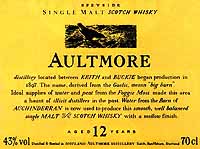 Single Malt Whisky
is the direct result of distillation of malted barley. A single malt is
produced by one distillery, athough it is possible the bottle contains
whisky from different barrels, even from different distillation years.
This is done to maintain a certain constance in the taste over the years.
Sometimes whisky is sold as "Single Cask", which means that
the whisky has matured in the same cask, without mixing casks.
Single Malt Whisky
is the direct result of distillation of malted barley. A single malt is
produced by one distillery, athough it is possible the bottle contains
whisky from different barrels, even from different distillation years.
This is done to maintain a certain constance in the taste over the years.
Sometimes whisky is sold as "Single Cask", which means that
the whisky has matured in the same cask, without mixing casks.
The ingredients are Barley, water and yeast.
 The barley
is at the base of all the process. The quality of the barley has a great
influence on the quality of the end product. The barley being used for
the production of whisky is carefully selected. It is after all the basic
ingredient which will determine the quality of the whisky which will be
sold years later. This selection was traditionally the job of the manager
of the distillery. Most of the distilleries nowadays buy their malt in
a malting plant for economic reasons, this selection is done less and less
by the distillery managers, but well by the persons in charge at the malting
plant. However, the maltings must respect precise requirements from the
distilleries, in order to let them produce their whisky properly, and on
the same way year after year. There is no legal obligation to use Scottish
barley to produce Scotch whisky. Even if some producers would like to go
back to the tradition, most of the distilleries are not concerned by the
origin of their barley. The most important thing is the highest sugar content
and the lowest price. The combination of those two elements is often the
only criteria in the choice of a variety of barley. A great deal of the
barley used to produce Scotch whisky is coming from England or South Africa.
The barley
is at the base of all the process. The quality of the barley has a great
influence on the quality of the end product. The barley being used for
the production of whisky is carefully selected. It is after all the basic
ingredient which will determine the quality of the whisky which will be
sold years later. This selection was traditionally the job of the manager
of the distillery. Most of the distilleries nowadays buy their malt in
a malting plant for economic reasons, this selection is done less and less
by the distillery managers, but well by the persons in charge at the malting
plant. However, the maltings must respect precise requirements from the
distilleries, in order to let them produce their whisky properly, and on
the same way year after year. There is no legal obligation to use Scottish
barley to produce Scotch whisky. Even if some producers would like to go
back to the tradition, most of the distilleries are not concerned by the
origin of their barley. The most important thing is the highest sugar content
and the lowest price. The combination of those two elements is often the
only criteria in the choice of a variety of barley. A great deal of the
barley used to produce Scotch whisky is coming from England or South Africa.
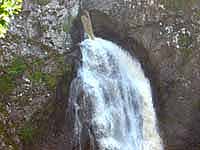 Water
is another of the most important ingredients in the making process of whisky.
The quality of the whisky depends on the quality and purity of the water.
Water in Scotland is famous for its great purity. The difference in taste
between the whisky coming from various distilleries is partly due to the
quality of water used. Water in the Highlands is often peaty, which gives
it a brownish colour. Substances, deriving from peat, are carried by the
rivers which water is used to make whisky, and contribute often to the
original taste of scotch whisky. But water is certainly not the only determining
factor in the taste of a malt whisky. The manufacturing process is of course
very important in the final taste of whisky. Water is used in several steps
during the distillation process. First of all, it is mixed to the grinded
malt in order to produce the wort. It is also used for cooling the alcohol
leaving the still. Last but not least, water is used to reduce the alcohol
at bottling.
Water
is another of the most important ingredients in the making process of whisky.
The quality of the whisky depends on the quality and purity of the water.
Water in Scotland is famous for its great purity. The difference in taste
between the whisky coming from various distilleries is partly due to the
quality of water used. Water in the Highlands is often peaty, which gives
it a brownish colour. Substances, deriving from peat, are carried by the
rivers which water is used to make whisky, and contribute often to the
original taste of scotch whisky. But water is certainly not the only determining
factor in the taste of a malt whisky. The manufacturing process is of course
very important in the final taste of whisky. Water is used in several steps
during the distillation process. First of all, it is mixed to the grinded
malt in order to produce the wort. It is also used for cooling the alcohol
leaving the still. Last but not least, water is used to reduce the alcohol
at bottling.
Yeast will start the fermentation process. The choice of the yeast is part of manufacturing secret of the distilleries.
The production process of whisky takes at least 3 years. If the spirit do not stay for at least 3 years in an oak cask, it does not deserve the name of whisky. Even worse, it does not have legally the right to be marketed under the name of whisky. To deserve the name of Scotch, the whisky has to stay for this minimum of 3 years on the Scottish ground. Generally, the whiskies marketed as single malt aged for a minimum of 8 to 10 years. Whisky, just like any other alcohol, is the result of natural chemical alterations of sugar.
To produce alcohol, we first need to produce sugar. Sugar is potentially present in barley, which grows easily under the Scottish latitudes. Many alcohols are made from grapes, but the climate of Scotland is not suited for this kind of culture. Nevertheless the manufacturing process remains very similar to the one used in production of alcohol based on other raw material.
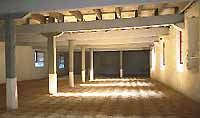 Malt is
the result of the malting process. The barley is made wet and spread on
the malting floor to allow the germination process to start.
A succession of chemical reactions change the starch contained in the barley
in sugar. Later sugar will change into spirit. The malting art consist
of finding the right moment to stop the germination process: not too late
but not too early. According to the season, malting takes between 8 and
21 days. Constant attention has to be given to the process. Barley has
to be turned over regularly to ensure a constant moisture and temperature
and to control the germination of the barley grains.
Malt is
the result of the malting process. The barley is made wet and spread on
the malting floor to allow the germination process to start.
A succession of chemical reactions change the starch contained in the barley
in sugar. Later sugar will change into spirit. The malting art consist
of finding the right moment to stop the germination process: not too late
but not too early. According to the season, malting takes between 8 and
21 days. Constant attention has to be given to the process. Barley has
to be turned over regularly to ensure a constant moisture and temperature
and to control the germination of the barley grains.
The end of the germination is triggered by drying the germinating barley over a fire in an oven or kiln. This oven is often heated by peat. The smoke of the peat fire in the kiln is determining the taste of the whisky. Germination is stopped by drying the grains above a kiln. A kiln was often fed with peat. It is the smoke of the peat fire which gives whiskies their particular flavour. The art is in the correct proportioning of peat used to dry the malt.
 Malting happens mainly
at specialized plants, called maltings. These maltings produce
malt according to the requirements of their clients. The same malting company
produces thus several kinds of malt. There are however notable exceptions
to that rule: Balvenie, Laphroaig, Highland Park, Bowmore are some of the
distilleries which produce parts of their own malts and only Springbank
produces 100% of their malt. Maltings can be independent, or belong to
big concerns, owning their own distilleries, like Diageo (see left picture). Diageo,
who owns a great deal of the Scottish distilleries, has created its own
malting plants, to supply the distilleries of the group or for local distilleries.
Malting happens mainly
at specialized plants, called maltings. These maltings produce
malt according to the requirements of their clients. The same malting company
produces thus several kinds of malt. There are however notable exceptions
to that rule: Balvenie, Laphroaig, Highland Park, Bowmore are some of the
distilleries which produce parts of their own malts and only Springbank
produces 100% of their malt. Maltings can be independent, or belong to
big concerns, owning their own distilleries, like Diageo (see left picture). Diageo,
who owns a great deal of the Scottish distilleries, has created its own
malting plants, to supply the distilleries of the group or for local distilleries.
When the malt is dry, it is grinded to make a kind of coarse flour which will be used in the next operations. This flour is called grist. Malt grinding is done with a malt mill in the distillery itself. Nearly all the distilleries use the same kind of mill, traditionally made in Leeds, England.
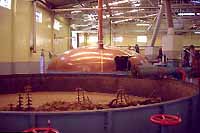 The grist will be mixed with hot water in the mash tun. Generally
one volume of grist is mixed up with 4 volumes of water. In this operation,
3 successive waters are used, at a temperature between 63 and 95°.
A mash tun can contain up to 25000 litres and has a double bottom with
thin perforations to let the sugared liquid resulting of the brewing operation
flow out. A considerable part is then sold as cattle food. In order to
facilitate the process, mash tun have rotating blades. The waste is called
draff.
The grist will be mixed with hot water in the mash tun. Generally
one volume of grist is mixed up with 4 volumes of water. In this operation,
3 successive waters are used, at a temperature between 63 and 95°.
A mash tun can contain up to 25000 litres and has a double bottom with
thin perforations to let the sugared liquid resulting of the brewing operation
flow out. A considerable part is then sold as cattle food. In order to
facilitate the process, mash tun have rotating blades. The waste is called
draff.
 The first operation,
taking about 1 hour, will change the starch in fermenting sugars. The mix
of water and grist looks like porridge. This sugared juice is called wort
(on the left picture you can see a wort cooler). The remainders will be brewed 3 to 4 times, in order to get a maximum of
wort. The quality of the wort is controlled by the excise men, because
it determines the amount of spirit which will finally be produced. This
is the base of the taxation of the distillery.
The first operation,
taking about 1 hour, will change the starch in fermenting sugars. The mix
of water and grist looks like porridge. This sugared juice is called wort
(on the left picture you can see a wort cooler). The remainders will be brewed 3 to 4 times, in order to get a maximum of
wort. The quality of the wort is controlled by the excise men, because
it determines the amount of spirit which will finally be produced. This
is the base of the taxation of the distillery.
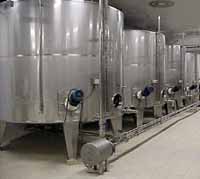 In order to start the
fermentation
of the wort, yeast is added. The action of the yeast on the
sugar of the wort will produce alcohol and carbon dioxide. The wort starts
bubbling, which will sometimes result in strong vibrations of the wash
back, despite its impressive size. Traditional wash backs are made of Oregon
pinewood or scottish larch. However, more and more stainless steel wash
backs are used nowadays, because they are easier to maintain. The result
of the fermentation of the wort is a kind of beer with a percentage of
approximately 8%. Till now, there are no substantial differences in the
process of making whisky, and the making of beer. From now the difference
between the process will become obvious. Beer will be perfumed with hops,
while whisky will be distilled without alterations.
In order to start the
fermentation
of the wort, yeast is added. The action of the yeast on the
sugar of the wort will produce alcohol and carbon dioxide. The wort starts
bubbling, which will sometimes result in strong vibrations of the wash
back, despite its impressive size. Traditional wash backs are made of Oregon
pinewood or scottish larch. However, more and more stainless steel wash
backs are used nowadays, because they are easier to maintain. The result
of the fermentation of the wort is a kind of beer with a percentage of
approximately 8%. Till now, there are no substantial differences in the
process of making whisky, and the making of beer. From now the difference
between the process will become obvious. Beer will be perfumed with hops,
while whisky will be distilled without alterations.
The distillation is the process used to separate alcohol from water and other substances contained in the wash. Distillation is made in stills. Water evaporates at 100° while alcohol does from 80°. Alcohol will thus be transformed in vapour and raises into the still before water itself begins evaporating.
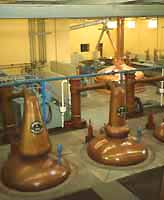 In Scotland distilling
pots are used. The size of the stills is fixed by the law.
This is due to historical reasons, related to excise rights. Edradour has
the smallest legal stills of Scotland. If the stills were a bit smaller,
the distillery would lose its licence. Stills are in copper, because this
material has a great influence on the physical process of separation of
the waters and the spirits. The quality of the dram we will enjoy a few
years later depends partially on the copper surface being in contact with
the liquids during the distillation process. The shape, the height, the
length of the lyne arm etc. are also very important in the making of the
taste of the future whisky. If a distillery has to add or replace a still,
it will always try to get a still with the same capacity and the same shape,
in order to guarantee a constant quality to the whisky.
In Scotland distilling
pots are used. The size of the stills is fixed by the law.
This is due to historical reasons, related to excise rights. Edradour has
the smallest legal stills of Scotland. If the stills were a bit smaller,
the distillery would lose its licence. Stills are in copper, because this
material has a great influence on the physical process of separation of
the waters and the spirits. The quality of the dram we will enjoy a few
years later depends partially on the copper surface being in contact with
the liquids during the distillation process. The shape, the height, the
length of the lyne arm etc. are also very important in the making of the
taste of the future whisky. If a distillery has to add or replace a still,
it will always try to get a still with the same capacity and the same shape,
in order to guarantee a constant quality to the whisky.
Traditionally, the
stills were heated with coal or peat, depending on the areas and possibilities.
Currently, nearly all of them are heated with vapour, because this method
gives more control on the process. The fuel used to heat the vapour is
generally petrol, but sometimes coal is still used.
Scotch whisky is double distilled, with some exceptions to this rule, like Auchentoshan which is distilled three times, just like Irish whiskey. The distillation process occurs in two stages in two still with different capacity and shape. The first distillation occurs in the wash still whose capacity can be between 25.000 and 30.000 litres and transforms the wash in "low wine", at about 21% of alcohol. If the stills were originally heated with a naked fire, generally from coal or gas, the current stills are heated by a serpentine within the still, where the vapour is circulating. The alcohol vapours are cooled outside the still by condensers. The traditional condensers were serpentines immerged in a great open wooden back, containing cold water. Currently, most of the distilleries use vertical tubular condensers, because the output is better. Waste of the first distillation is called "pot ale" or "burnt ale", and is transformed to feed cattle too. The low wines resulting from this first distillation are kept in the low wine receiver and will be used as the basis for the second distillation.
 The second distillation
occurs in a spirit still which is generally smaller than the wash still,
as there is less liquid to process. During the second distillation, only
the "distillation heart", the part which has between 63 and
72% of alcohol, will be casked. The heads and tails, also called feints,
will go to the feint receiver, and reused mixed with the low wines of the
next distillation. To separate the feints from the distillation heart,
a spirit safe is used (see above picture). In past times this spirit safe was
used for the determination of the quantity of alcohol produced , to calculate
the taxes due by the distillery.
The second distillation
occurs in a spirit still which is generally smaller than the wash still,
as there is less liquid to process. During the second distillation, only
the "distillation heart", the part which has between 63 and
72% of alcohol, will be casked. The heads and tails, also called feints,
will go to the feint receiver, and reused mixed with the low wines of the
next distillation. To separate the feints from the distillation heart,
a spirit safe is used (see above picture). In past times this spirit safe was
used for the determination of the quantity of alcohol produced , to calculate
the taxes due by the distillery.
The distillation process is unique for each distillery using pot stills. This means that all the whiskies produced by a certain distillery are treated on the same way, with the same malt, the same stills on the same way by the same people. So, why can they be so different from each other? The answer to this question is in the aging process, the casks used, the nature of the warehouse, the taste of the air and some other criteria.
 If the surrounding air
has an influence on the taste of whisky, one must realize that many distilleries
bring their casks to a central place near Edinburgh for their aging. Why?
The influence of the air on the taste of whisky - is it myth or reality?
There is one thing for sure however, and that is that the role of quality
of the barley, the making process, and the nature and quality of the casks
where it was aged is very important. According to some specialists, this
could be good for 95% of the final quality of a malt whisky. To have the
right to bear the name of whisky, a grain spirit must be aged at least
for 3 years in an oak cask. Unlike Cognac which is stored in new casks,
the Scottish always use second hand casks.
If the surrounding air
has an influence on the taste of whisky, one must realize that many distilleries
bring their casks to a central place near Edinburgh for their aging. Why?
The influence of the air on the taste of whisky - is it myth or reality?
There is one thing for sure however, and that is that the role of quality
of the barley, the making process, and the nature and quality of the casks
where it was aged is very important. According to some specialists, this
could be good for 95% of the final quality of a malt whisky. To have the
right to bear the name of whisky, a grain spirit must be aged at least
for 3 years in an oak cask. Unlike Cognac which is stored in new casks,
the Scottish always use second hand casks.
The oak casks are classified by capacity. The shape of the casks is mainly due to historic reasons, related to storage problems on ships. Sherry was carried on Spanish gallions, and the slender shape of the butts was the best for storing on this kind of ships, while the Portuguese Port was stored in a more bulbous cask, which was easier to carry on Portuguese merchant ships. Often whisky is aged for a while in bourbon casks finishing his aging period of 6-12- months in some kind of other cask, in order to give it some new fragrances, before bottling. This explains the "wood finish" mention on some bottling's.
A whisky cask is always a second hand cask. It generally contained Bourbon or Sherry. Other casks are used too, like Port, Madeira and more rarely Claret or rum. Some of them are very expensive, probably because of the rarity of the casks. However, there is a question about this wood finishes. If the aim is to give some new and pleasant fragrances to the whisky, it is clear that this method is used sometimes to hide some distillation errors. Often, the casks are warmed up before transferring the whisky, in order to accelerate the fragrance transfer. Such practices are not acceptable, because the consumer has no way to know about this.
The angels share:
The nature of the warehouse
is also very important. A damp or a dry cellar will influence the evaporation
of the spirit differently. In a dry concrete cellar, water will evaporate
mainly, letting a dryer whisky with a higher alcoholic percentage. In a
damp warehouse with a beaten-earth floor the alcohol will evaporate, letting
a rounder whisky with a smoother taste.
During bottling, the
alcohol percentage is reduced. This is the other operation where the quality
of water has a great influence on the taste of whisky. The minimum percentage
of alcohol for whisky is 40%. Most of the bottles are marketed
at this percentage, because the excise rights are calculated on the alcohol
proportion in the bottle. The excise rights are particularly high in Great
Britain, but in other countries they are lower. That's why on the international
market, whiskies are frequently bottled at 43%. For some technical reasons,
the ideal percentage for bottling without chill filtering seems to be 46%.
Most of the non chill filtered whiskies are marketed at 46%.
Often whisky is not
diluted when bottled. That's called cask strength bottling.
Generally, the casks are mixed before bottling, to get a more standardized
product, just like great wines. When the whisky comes from just one cask,
it is called "single cask".
Most of the distilleries
do not bottle their own whiskies, but let this happen at specialized plants.
Exceptions among others are Glenfiddich, Springbank, Bruichladdich and
Loch Lomond. Even if they do not bottle themselves, the responsibility
of the bottling stays from the distillery. This is called "official
bottling". This operation happens often in the suburbs of Edinburgh
where several bottling plants are installed, belonging to distilleries
or to independent bottlers.
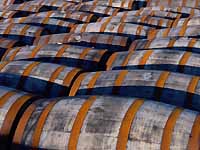 There is a very big
cask industry. There are about 100 active distilleries all over
Scotland. The average production of each of them is between 1.200.000 and
2.000.000 litres a year. To deserve the "Scotch label", whisky must stay
at least 3 years on the Scottish territory in oak casks. Assuming that
the annual production is about 150.000.000 litres, the absolute minimum
of whisky stored in Scotland is 450.000.000 litres.
There is a very big
cask industry. There are about 100 active distilleries all over
Scotland. The average production of each of them is between 1.200.000 and
2.000.000 litres a year. To deserve the "Scotch label", whisky must stay
at least 3 years on the Scottish territory in oak casks. Assuming that
the annual production is about 150.000.000 litres, the absolute minimum
of whisky stored in Scotland is 450.000.000 litres.
 This only to guarantee
the legal right to be called Scotch whisky. This is without taking in account
the huge quantity of whiskies which are aging for 10 to 30 years. On the
other hand, the casks used for storing whisky are never new ones. It is
thus very important to maintain the casks in good state. Some distilleries
have their own cooperages but most of them prefer outsourcing this to specialized
companies. There are lots of cooperages in Scotland, and the most famous
of them is the Speyside Cooperage, situated half way between
the Glenfiddich distillery and Dufftown (see above picture). This cooperage has about 300.000
casks in stock. All of them need reconditioning. There are about 20.000.000
cask all over Scotland. A cask can be (re)used for a maximum of 60-70 years.
This only to guarantee
the legal right to be called Scotch whisky. This is without taking in account
the huge quantity of whiskies which are aging for 10 to 30 years. On the
other hand, the casks used for storing whisky are never new ones. It is
thus very important to maintain the casks in good state. Some distilleries
have their own cooperages but most of them prefer outsourcing this to specialized
companies. There are lots of cooperages in Scotland, and the most famous
of them is the Speyside Cooperage, situated half way between
the Glenfiddich distillery and Dufftown (see above picture). This cooperage has about 300.000
casks in stock. All of them need reconditioning. There are about 20.000.000
cask all over Scotland. A cask can be (re)used for a maximum of 60-70 years.
The advantage of oak
for maturing alcohol is that it is not airtight. It lets surrounding air
enter the cask which explains the salted taste of a whisky aging near the
sea, but it also lets evaporate the whisky it contains. It is generally
admitted that between 1 and 2% a year evaporates this way. Evaporation
can affect the water contained in the cask, but also the alcohol itself,
resulting in a diminution of the alcohol percentage. That is called "the
angels share". However, this percentage is theoretical, because this could
result in a strange situation, as old whiskies (30 years and more) would
lose their right to be called whisky. Indeed, assuming a whisky has about
70% of alcohol when it leaves the spirit still, and loses about 1% of alcohol
a year a 30 years old whisky would just have a percentage of 40%, which
is the lowest limit for a whisky. The angels share is indeed the part of
alcohol which escapes to excise rights. Excise rights are calculated on
the amount of alcohol coming out of the still and not on the amount of
water. As this amount is diminishing over the years, the marketed whisky
would be taxed using the alcohol percentage it had when it was distilled.
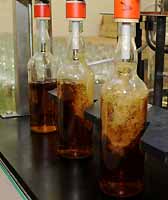 Bottling
is the last step before putting the whisky on the market. Unlike wine,
whisky does not mature anymore in the bottle. So a 12 years old whisky
stays a 12 years old even 12 years later, and does not become a 24 years
old one. When bottling, some residues are left in the whisky. The effect
of this is that whisky looks "cloudy", and this is not always appreciated
by the consumer. That's why distilleries found out the "chill filtering",
which removes all this residues. The problem with chill filtering is that
it also removes parts of the fragrances and of the taste. With the current
revival of single malt, more and more bottlers bottle their whiskies without
chill filtering.
Bottling
is the last step before putting the whisky on the market. Unlike wine,
whisky does not mature anymore in the bottle. So a 12 years old whisky
stays a 12 years old even 12 years later, and does not become a 24 years
old one. When bottling, some residues are left in the whisky. The effect
of this is that whisky looks "cloudy", and this is not always appreciated
by the consumer. That's why distilleries found out the "chill filtering",
which removes all this residues. The problem with chill filtering is that
it also removes parts of the fragrances and of the taste. With the current
revival of single malt, more and more bottlers bottle their whiskies without
chill filtering.
The Scottish Whisky Distilleries:
There are so many whisky
distilleries in Scotland that this page would load too long.
Please click the following
link to have a closer look at the more important
Whisky
Distilleries
Subscribe to the illustrated email magazine
"Scotland Forever"
Copyright © 2022 by Mag. Peter Csar - All rights reserved.
